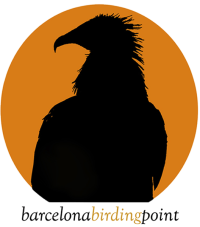Morocco Birding Tour 2022 Trip Report
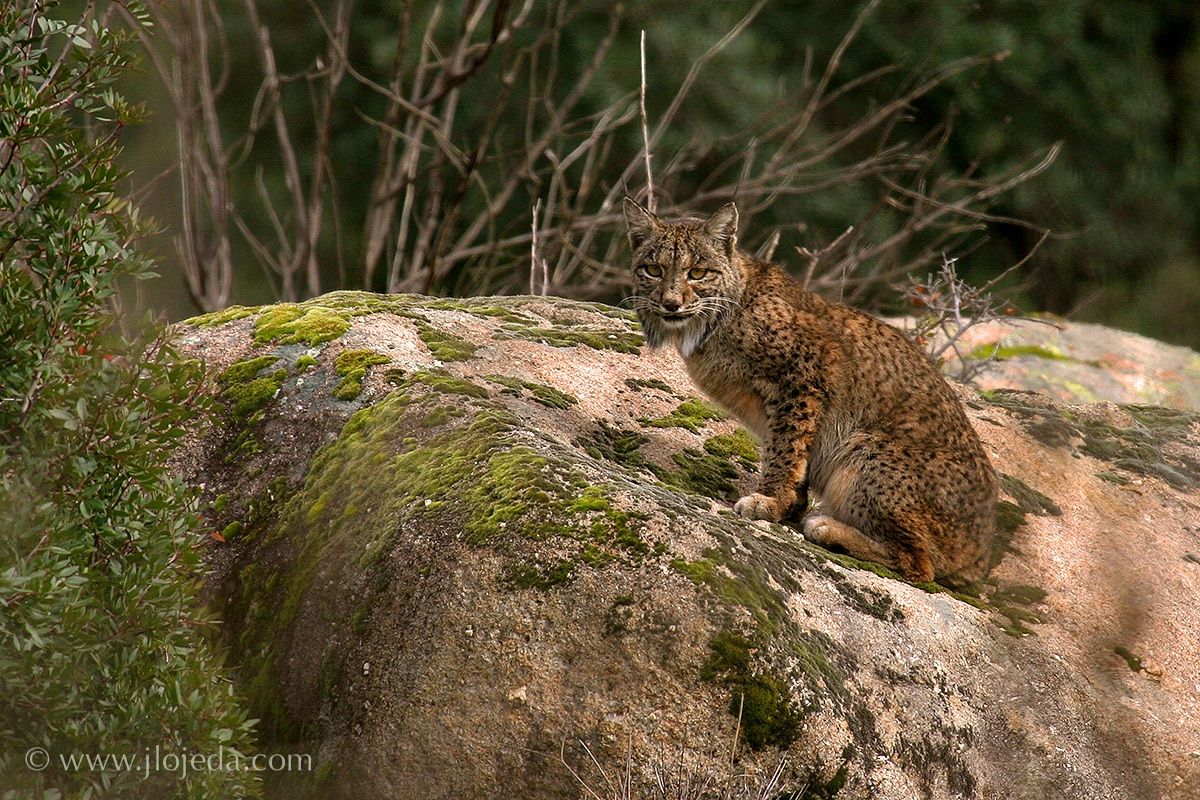
- Dates: March 12th to March 25th, 2022
- Number of participants: 6
- Species seen: 190
All images in this trip report by Carles Oliver. All rights reserved.
Overview. Our 8th tour to Morocco explored again one of the most popular routes in Southern Morocco. Combining excellent mountain birding in the Atlas with the stunning variety of birdlife living in the transitional plains between the mountains and the Sahara, this tour embraces a good array of habitats that provides excellent chances for all the main specialties living in the area. This year, the tour was marked by an unusual cloudy weather and very cold temperatures. During our stay in Agadir, we had general rains in the area, and the snow was appearing a pair of times during the tour. This situation was translated in a poor bird migration, with several trans-Saharan migratory species showing very thin numbers, when not being totally absent from our trip list. Despite the general unusual weather, we got excellent views on all specialties out of Thick-billed Lark. The tour had also a pair of very interesting birds, as males Little Crake and Pallid Harrier were seen both around Ouarzazate.
Day 1: Early breakfast in our hotel in Marrakech before going out and enjoy a sunny but rather fresh day. All tour participants were arriving along the day before in a number of afternoon flights, and we all met for an evening meal.
Before getting to the van we had some nice looks to the Marrakech urban birdlife. A number of Pallid Swifts were flying low, and we got good views on the colour and structure. On the same hotel, two House Buntings were singing their heart out while Sardinian Warblers, Common Bulbuls, Spotless Starlings and Eurasian Greenfinches were also noted.
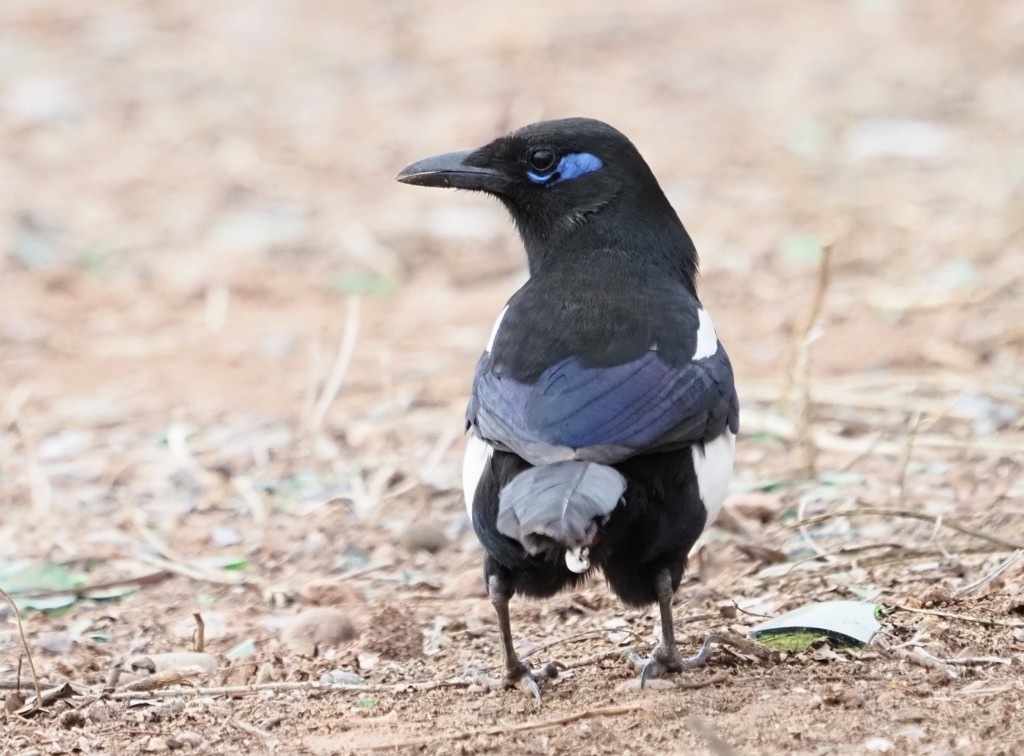
In our way out of Marrakech we had first views on Maghreb Magpies, a recent split from Eurasian Magpies, on the wires or feeding on the ground, often along with Cattle Egrets. Our first stop was to explore a lovely valley in the Atlas. Here, small patches of riverside forests are surrounded by the wallnut orchards while the slopes around are fittered with Juniper srublands. Soon after living the van we had our first Levaillant’s Woodpecker (aka Atlas Green Woodpecker) nicely showing. We could all have excellent views while the bird was slowy moving in the branches of tree, in an interesting warbler-like behaviour. 2 African Blue Tits appeared as well in the same place, and a showy Eurasian Wren was a nice adding. Great Tit was calling in the distance, and European Serins were moving all around. A bit more of time in this wonderful location allowed us to have 3 Little Swifts, our first Moroccan Wagtail, Great Spotted Woodpecker and lovely views on a male Cirl Bunting.

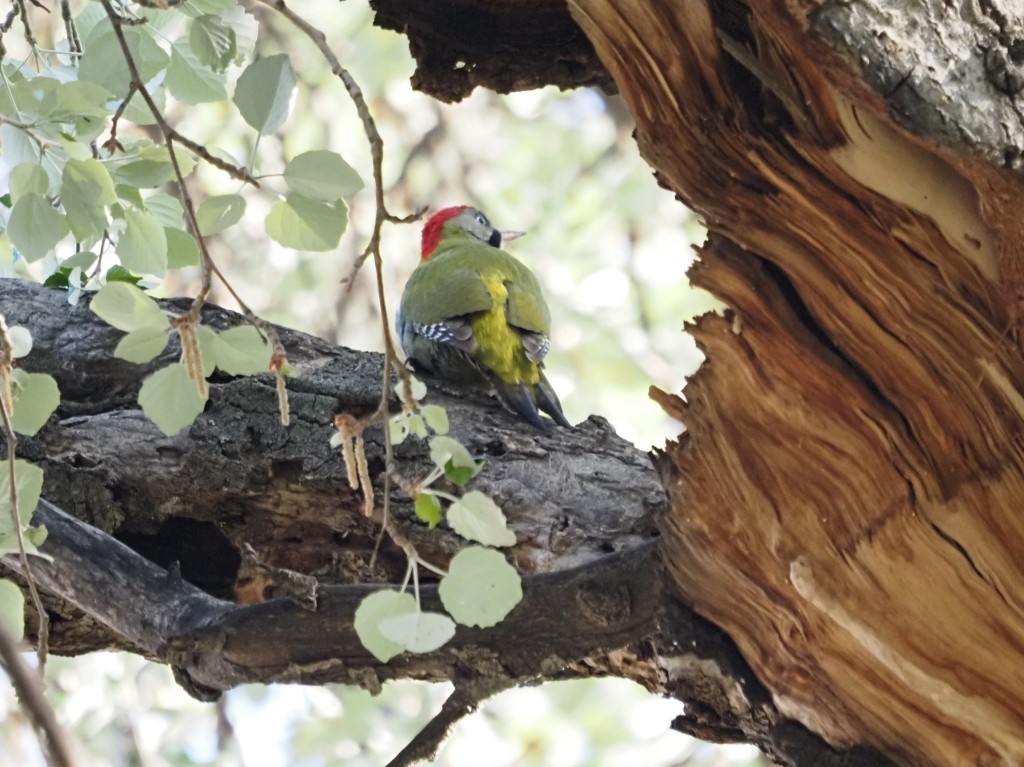

We move on from this wonderful corner to go up in the hillsides. As normal, we had some good roadside birding, and Lesser Kestrels and Eurasian Sparrowhawk were noted while moving up. Once arrived to a typical habitat we had a second stop, successful again. Soon after we got out of the van a wonderful Tristam’s Warbler was moving really close while feeding in the Junipers. Another bird was singing up in the slope and provided good looks while showing on the top of a bush. Around the area we also had two Atlas Coal Tits (a potential split) and a wonderful Rock Bunting calling while doing its way in a barren slope. However, the suprise of the stop was to see 3+ Ring Ouzels (torquatus race) moving in the scrublands and on the ground while looking for berries.
Back to the lane, we kept doing our way up until a large flock of Red-billed Choughs came to us in a wonderful aerial spectacle. The birds were not only playing with the wind in the slopes, but also harrasing an Atlas Buzzard (still considered a race of Long-legged Buzzard, but who knows for how long). A fast stop by the road was required, and happily all the tour participants could connect with this amazing bird of prey, clearly smaller and short-winged than nominals Long-leggeds. But we were still luckier when a Barbary Falcon joined the show for a while, and offered nice views while flying quite lower than the Choughs themselves!


Happy after such a wonderful road side stop, we kept our way to arrive to Oukaïmeden. Once in the area, we did a short walk in the plain and we fast had a flock of 6 Rock Sparrows that gave us nice views. Black Redstarts and Black Wheatears were around, and we were lucky enough to see White-throated Dipper in the stream and 1 Alpine Accentor that flew along right in front of us, but the main attractions of the place kept elusive for us.
We decided to do a lunch stop, and enjoy the good food up in the mountains. After lunch we went for a second shot in the plains and we were definately luckier, since a female African Crimson-winged Finch appeared sitting on a wire and, after a bit of walk, we all enjoyed excellent views on the bird! It was certainly strange to have a single individual here, contrasting with flocks that we normally find but never mind. We really took that!
A last stop was required before stating going down to Marrakech. In a small corner of the plain (a typical place for them to be) we found 12+ Atlas Horned Lark, a very distictive, resident race of Horned Larks, and again a good candidate for a future split.
Out of mountains, we still decided to go for a final stop before going back to our accommodation. The Southern part of Marrakech has lovely fields and a good array of birdlife living on them. Here we had a stop to and we were granted with a lovely flock of European Serins, Spanish Sparrows, Corn Buntings, Crested Larks, Zitting Cisticolas, European Stonechats plus the views on species such as Moussier’s Redstart and Woodchat Shrike. But the main character and the authentical reason of our stop was to look for Barbary Partridges, and we were lucky enough to find 3+ of them doing their way in the fields, and trying to disapear in the open terrain.



Day 2. Transfer day from Marrakech to the Agadir area. A transfer was more complicated due to the difficult traffic around Agadir. Our first stop was in Essaouira, where we enjoined some good birds South of the city. Here we had first views on Ruddy Shelducks but also Pied Avocets, Black-winged Stilts, 2 Green Sandpipers, Wood Sandpiper, 1 Ruff, 14 Eurasian Spoonbills, Greater Flamingoes, Common Redshanks, 3 Little Ringed Plovers and 1 Common Snipe. Some other species, although more distant, included 3 Audouin’s Gulls + 1 Mediterranean Gull and 3 Sandwich Terns roosting along with large numbers of Yellow-legged Gulls (probably coming from the Mogador Island colony) and a single Lesser Black-backed Gull.
Our journey kept to the South, following the wonderful coastal route that, crossing slopes fittered with Argan trees, arrives to the Tamri Estuary. Here we had a walk and soon we had good views on Northern Bald Ibis flying above us. The walk goes along the coastal dunes, with many Lesser Black-backed Gulls moving up in down along the coast. A scan into a flock of gulls roosting in the beach produced to less than 40 Audouin’s Gulls and some nice-looking Kentish Plovers. But the main attraction was still to come when a Northern Bald Ibis just landed a few metres away from us, and started to look for food in the sand. Digging its bill in the dunes, the bird showed really suggessful and got warms and some small insects. After 20 minutes of wonderful sighting, joined by two pairs of Moussier’s Redstart, we did a last stop further South, in the Cape Tamri.
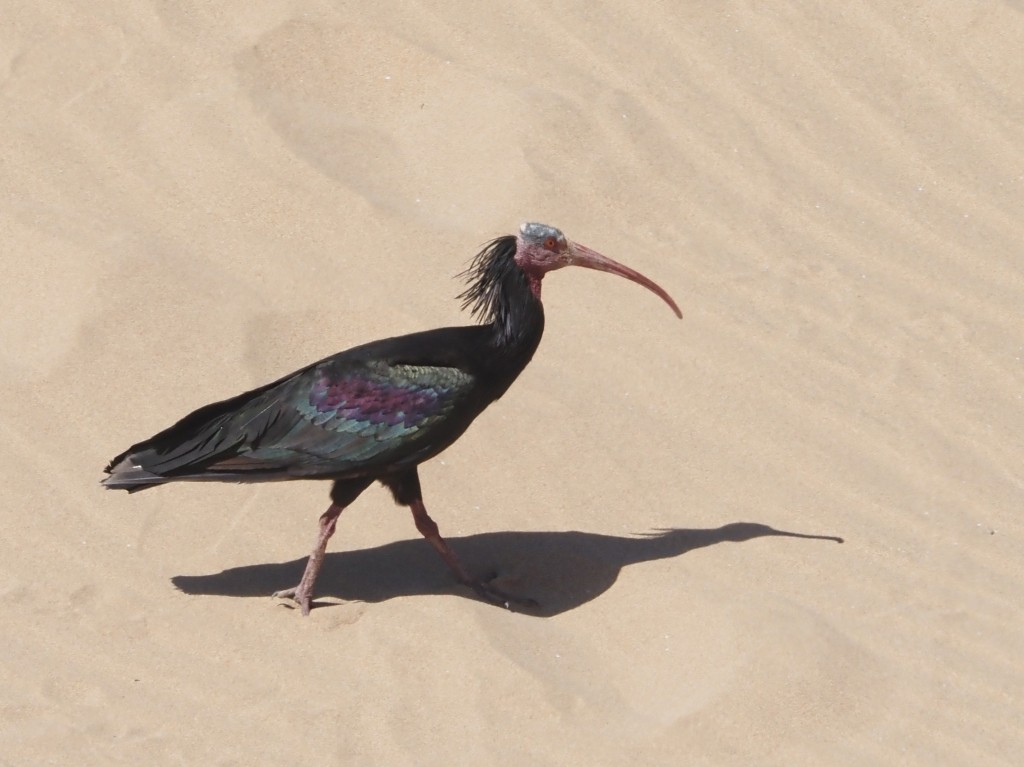

This location proved in other issues to be excellent for seawatching, but this time all the birds were seen really far away, and the counts were not above 25 Northern Gannets moving North and some Sandwich Terns moving around. The stop was complemented with great views on tame Thekla Larks moving around the rocky outcrops and 2 Algerian Shrikes (the race of Great Grey Shrike living in Northern Morocco and along the Atlantic coast).
We started moving to our accommodation, with a last stop in mind, but our changes of this last birding stop vanished into a large traffic jump due to road works.
Day 3. Our day in the Souss-Massa National Park started with a pair of short walks to catch up with some specialties around. The weather was clearly changing, with a massive low pressure system coming from the Atlantic Ocean and threatening with strong rains and lower temperatures. Still, we managed a pair of successful stops in the morning.
Our first stop was to explore a small corner of the Massa River. In the past, this area showed a wonderful variety of birdlife, including several migratory birds. But this year the water level (like in many other corners along the Massa River) was really low, and the migratory birds almost absent. A short stroll rapidly produced good views on Cetti’s Warbler and African Chaffinches. Several Common Chiffchaffs were moving around, and a obliging pair of Moussier’s Redstart provided great views. In the distance, a Black-winged Kite was whovering above the farming around the river. After some scanning, we were able to locate a wonderful Black-crowned Tchagra moving in the lash vegetation, and with some patience we all enjoyed great and close views on it!



The clouds were already coming, and temperature was getting down (collapsing!), but we managed a second stop before the heavy rain arrived. In a small patch of reeds and tamarisks we found the first Western Olivaceous Warbler (aka Isabelline Warbler) of the trip moving in the vegetation and going on with what it sounded like a subsong. 3 Eurasian Spoonbills were feeding in a small pond along with 1 Common Sandpiper and 1 Little Ringed Plover. Some Little & Pallid Swifts flew above us, providing good looks while we moving away from the river to have a short exploration of the fields around. A flock of 35 Eurasian Siskins was quite a surprise so far South, but little more could be added out of 1 Meadow Pipit and Moussier’s Redstarts. It started to rain heavily so we decided to go back to our accommodation. In our way back, a Little Owl was a nice find!
The heavy rain tied us to ous hotel until mid-afternoon, when the rain stopped and we could go out. There were still some clouds, but had to move! Another potentially good corner in the river Massa was also rather quiet, but we still had 4 Plain Martins flying around, brief views on 1 Bluethroat, Maghreb Magpies, a distant Western Swamphen, 1 Purple Heron and a small flock of Pied Avocets feeding nearby the bridge. Beyond this point, the area become more bushy, with formidable formations of euphorbias. Here we did a second stop, and we were granted with 3 Western Black-eared Wheatears, European Bee-eaters, Sardinian Warblers, 2 Eurasian Hoopoes, 2 Cirl Buntings at close range and 1 Great Spotted Cuckoo! We were all quite satisfied with this, and we drove back to the hotel for an early dinner. After dinner, more birds!
A short walk from our accommodation, and a bit of luck, provided great views on 1 Red-necked Nightjar calling, flying and briefly stopping around us in a great sight that, for our clients, ranked among one of the 10 better birds of the trip!!!




Day 4. Transfer day between Agadir and Ouarzazate. The morning was again really cold (only 10ºC!!) and with some rain. Despite the bad weather we did stop in the Massa River, and we had a good hearing on 3 Black-crowned Tchagras singing while a flock of Glossy Ibis was feeding around. A second morning stop in the Souss River estuary was way more productive. Here we got a really good selection of waders feeding in the mudflats along with several Eurasian Spoonbills, some Greater Flamingoes, Mediterranean Gulls and a Lesser Kestrel hunting dragonflies!
It was quite a surprise the good number of Black-tailed Godwits in the estuary feeding along with several Black-winged Stilts and Pied Avocets. A minimum of 48 Ruffs were also counted, and 27 Curlew Sandpipers. 3 Spotted Redshanks were also noted along with many Common Redshanks, Grey Plovers, Eurasian Whimbrels and some Wood Sandpipers. A careful scanning revealed also 1 Temminck’s Stint, 2 Red Knots, 4 Eurasian Curlews, 4 Bar-tailed Godwits and a flock of 7 Little Stints. Surprisingly we only counted 4 Common Ringed Plovers in the whole estuary!


A short walk along the more vegetated areas produced some Yellow Wagtails and short views on a (white-spotted) Bluethroat.
After this pleasant stop we went on with our transfer along the Anti Atlas. The roads between Agadir & Ouarzazate goes along one of the best areas for birds of prey in Morocco. With the Tawny Eagle and Chanting Goshawks both gone for long, the area remains as an interesting hot-spot for birds of prey such as Black-winged Kite. Along the road, we counted up to 4 Black-winged Kites, but also Black Kites, our first Short-toed Snake Eagle and 1 Barbary Falcon.

One of the best stops on this road birding provided excellent views on a Great Spotted Cuckoo singing from the top of an Argan Tree. Some tens of miles away from the cuckoo, another stop was mandatory when we found 4 obliging Cream-coloured Coursers and 2 Desert Larks just by the tarmac!


In the afternoon we were already close to Ouarzazate, when we crossed one of the many streams coming down from the Atlas. There, roosting in the reedbeds, there were several Little Egrets and 4 Black-crowneds Night Herons. A stop was, obviously, mandatory!
The vegetation along the stream was full of Sedge Warblers that were feeding along with 1 or 2 Eurasian Reed Warblers while the first Willow Warbler of the trip was moving in a tall grass right beyond. We were really enjoying the views on these little fellas just when 1 male Little Crake decided to walk out of the vegetation, showing himself in a superb afternoon light! The bird was there for 10 minutes, in what it was a lifer bird of more than the half of the group! Then somebody advaced about a bird of prey coming from the right, and we all had the time enjoy a superb Bonelli’s Eagle diving right beyonf the stream, tallons in the front of, probably trying to catch a prey!
Everybody was really excited, and the Little Crake was still in the out, but a Eurasian Wryneck just called in our back. Time to move to the small Almond plantation and try to find the Wryneck. We moved slowly in the fields with scatered large Almond trees, when a small bird just flew off from the grass and landed low in small bush: 1 Common Grasshoper Warbler! It took me 10 minutes to put everyone in the bird, but we did it!!!
Back to the Wryneck operation, we moved around the area and found a lovely European Turtle Dove sitting on a tree. A tour participant found a Woodchat Shrike in a large shrub and we all admired it but, by the time my bins came back to the tree where the Turtle Dove was, it was turned into the Wryneck that we had been looking for!! What a wonderful stop!!
And this is how a road birding day can turn out in a absolutely great birding day!
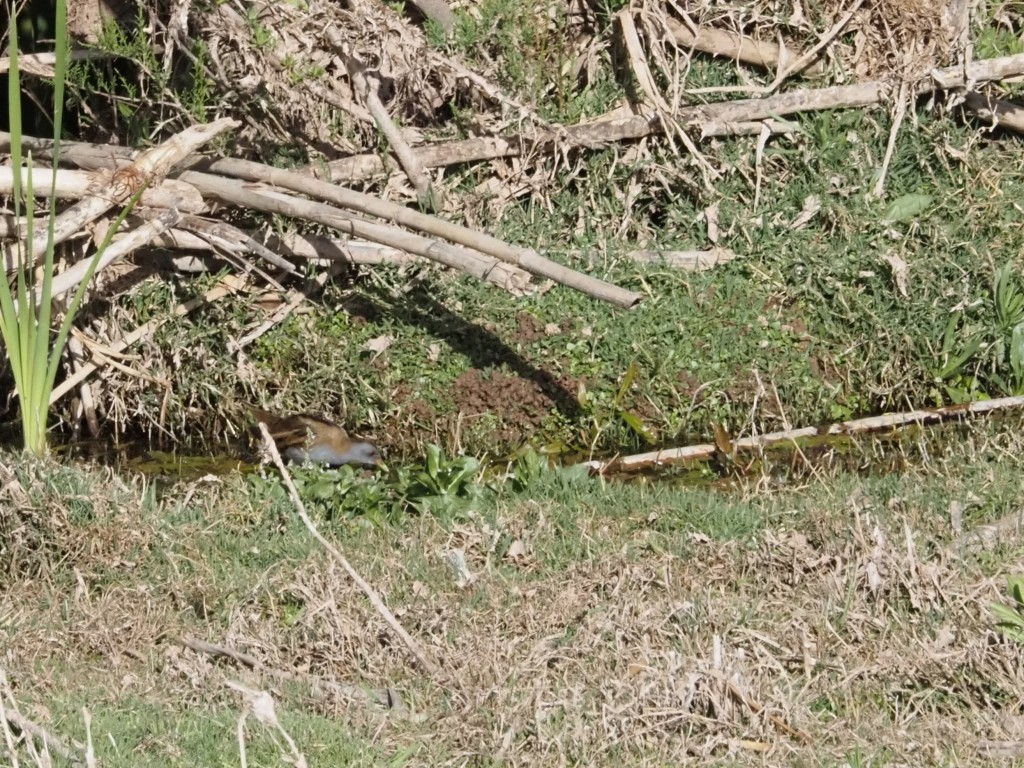

Day 5. Early morning start to explore the massive reservoir inmediatly South of Ouarzazate. Weather was still cloudy, and temperatures were far lower than expected. Still, we enjoyed another great day. Instead of heading directly to the reservoir, we drove a bit around the semi desert to try to find some specialties. There we had first views on Desert & White-crowned Black Wheatears but also a pair of Trumpeter Finches and 1 Spectacled Warbler. It was clear that it was some migration, since it was a flock after a flock of Greater Short-toed Larks moving North, and we got 17 Black Storks that seemed to be roosting in a distant plateau East of the reservoir.
Once in the lake, we had good views on both Maghreb & Thekla’s Larks. The shores were full with Ruddy Shelducks and the songs of migratory Sedge Warblers were all over. A distant Water Rail was also noted, while a large flock og 400+ White Storks were roosting in the reeds. On waders, it was low. We only had some Little Ringed Plovers, some Ruffs, Green Sandpipers, 2 Greenshanks and 3 Black-tailed Godwits.


A bit beyond we reached a view point over the reservoir and we soon had excellent but distant views over the many Marbled Teals around. We counted a minimum of 80 of them and, along with this really scarce duck, we enjoyed a good array of other ducks including Gadwalls, Northern Shovelers and Eurasian Teals, but also 1 female Eurasian Wigeon, 2 Tufted Ducks, 12 Common Pochards, 5 Garganeys and 2 Northern Pintails. In the lagoon we also got the only Great Crested Grebes of the trip while 2 Alpine Swifts flew over.
After some time scanning the lagoon we started to move. It was still cold and cloudy but it was evident that a good raptor migration was going on. Hundreds of distant Black Kites were cincling and moving North, 1 female Western Marsh Harrier was seen flying low and inmediatly after we got one of the surprises of the trip, a male Pallid Harrier that showed briefly while flying towards the Atlas! Unfotunately not everyone in the group got a proper view on this very scarce bird of prey!!
It was already late in the morning so we started moving East to arrive to our accommodation in Boulmane du Dades for an early lunch. The ambient here was even colder that it was in the morning, and we had lunch by the fire!
During the afternoon we had a first contact with the extensive steppe land inmediatly South of Boulmane. The light was poor and the temperature was only 6ºC, extremelly low for Morocco in this season. Still, it didn’t take long to have first views on Temminck’s Larks, and a proper stroll around produced a pair of Greater Hoopoe Larks, 1 Long-legged Buzzard, 1 Barbary Falcon a flock of 6 Cream-coloured Coursers and some Desert Wheatears.



Day 6. Full day enjoying the steppes and gorges around Boulmane. In the morning we had some stops in the plains, adding great views on Trumpeter Finches and Red-rumped Wheatears to our list. We were only 3ºC but the birding was still great, with several Temminck’s Larks around and migratory Greater Short-toed Larks feeding around. A short visit to proper fields around produced 8 Black-bellied Sansgrouses and, for our surprised, they were joined by 1 Pin-tailed Sandgrouse!
We were in a small lowland in the way to the Atlas, and a further exploration of the areas produced excellent views on Little Owls!
Our last stop of the morning was even better. A small corner in the plains that is normally a good place for Larks was having more than ever: 15+ Cream-coloured Coursers, 10+ Greater Hoopoe Larks, Mediterranean Short-toed Larks, Thekla’s Larks and Greater Short-toed Larks were all seen and enjoyed. A Tawny Pipit showed briefly and some bush around produced 2 Willow Warblers, 1 Tree Pipit, Linnets and 4 species of Wheatears (Northern, White-crowned Black, Red-rumped & Desert!).



In the afternoon the sun finally appeared, and temperature rose. We basically spent the afternoon in a pretty gorge close to Boulmane. There, we enjoyed great views on a roosting Pharaon Eagle Owl, but also a pair of Lanner Falcons, Black Wheatear, Desert Larks, a flyby Red-rumped Swallow and stunning views on a Maghreb Wheatear, one of the most sought-after birds of the country!



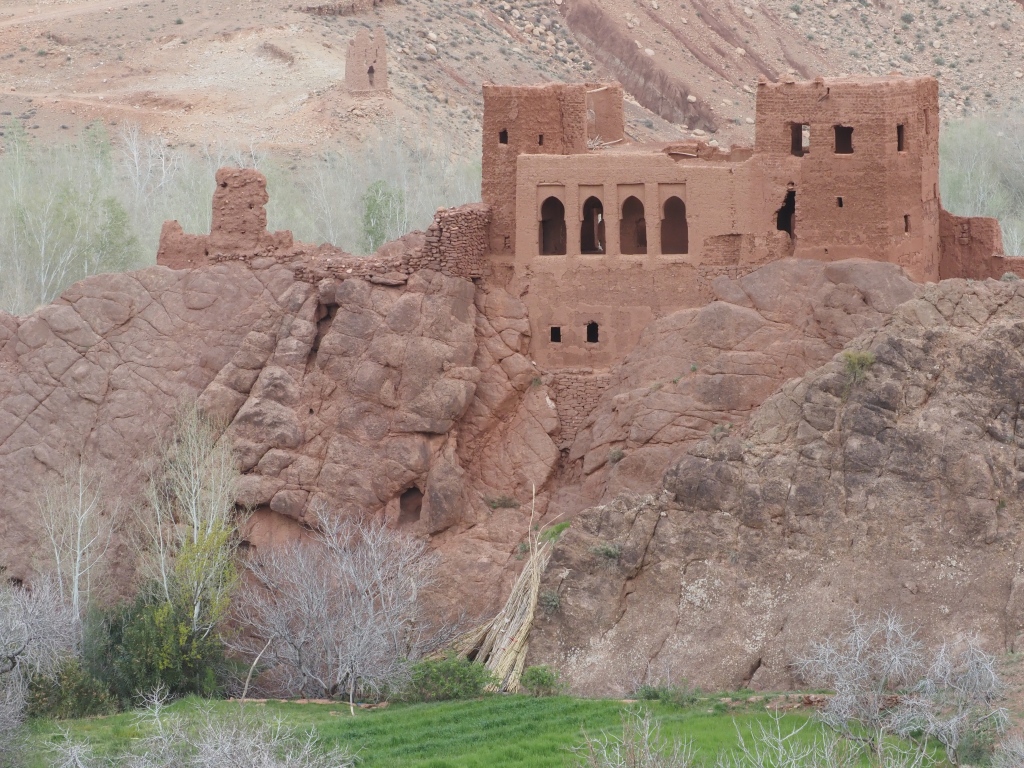
Day 7. In the morning we had another walk to explore a different corner in the plains, hoping to connect with Thick-billed Lark. It was no way to find this species but we enjoyed good views on Black-bellied Sandgrouses feeding on the ground and a good set of other larks.
After our en-route lunch we spent some time in a well-known spot in the desert, where we looked for the scarce and unobtrusive Saharan Scrub Warbler. The walk produced Woodchat Shrike, Tawny Pipit, Thekla Lark, Spectacled Warbler and the first Bar-tailed Lark of the trip. After some time looking for the famous Scotocerca, we were about to quit from our day quesy when one of the tour participants advaced us about a bird moving low in the scrubs. It took us about 25 minutes to put everybody in the bird but eventually there they were: A handsome pair of Saharan Scrub Warbler!



After this great sight we just drove to our accommodation down in the desert, with some road birding sights including Booted Eagle and Brown-necked Raven.
Day 8. Our day started in the desert by checking some great places for migratory song birds. Unfortunately, the extremely low temperatures of the last days was affecting the bird migration. Along the morning the number and variety of birds was extremely low. We still had good views on Western Subalpine Warblers, Western Bonelli’s Warblers, Common Redstarts, Eurasian Hoopoes, Willow Warblers and 3 Woodchat Shrikes. 1 Western Black-eared Wheatear was an unexpected sight, and we also enjoyed good views on Bar-tailed & Maghreb Larks.
But the bird of the day was the African Desert Warbler that we found nesting close to one of the main roads in the area, and that was providing really good looks!


Day 9. Early morning start to enjoy the birds of the desert. Our first stop was to visit a water hole in the dunes, and our efforts here were granted with great views on 80+ Crowned Sandgrouses and 40+ Spotted Sandgrouses that came down to drink water early in the morning. The images of these Sandgrouses drinking water is something that our clients will never forget!
A short drive for a coffee stop gave us access to one of the few Desert Sparrows left in the area, and we all again enjoyed really good views on a species that is becoming more and more scarce due to the concurrence of House Sparrows in the area. The morning ended with a last stop, this time to see 2 Egyptian Nightjars roosting in the dunes! Another amazing sight!!
During the afternoon, our clients had a free time to explore by their own the dunes and the bushland around the accommodation.
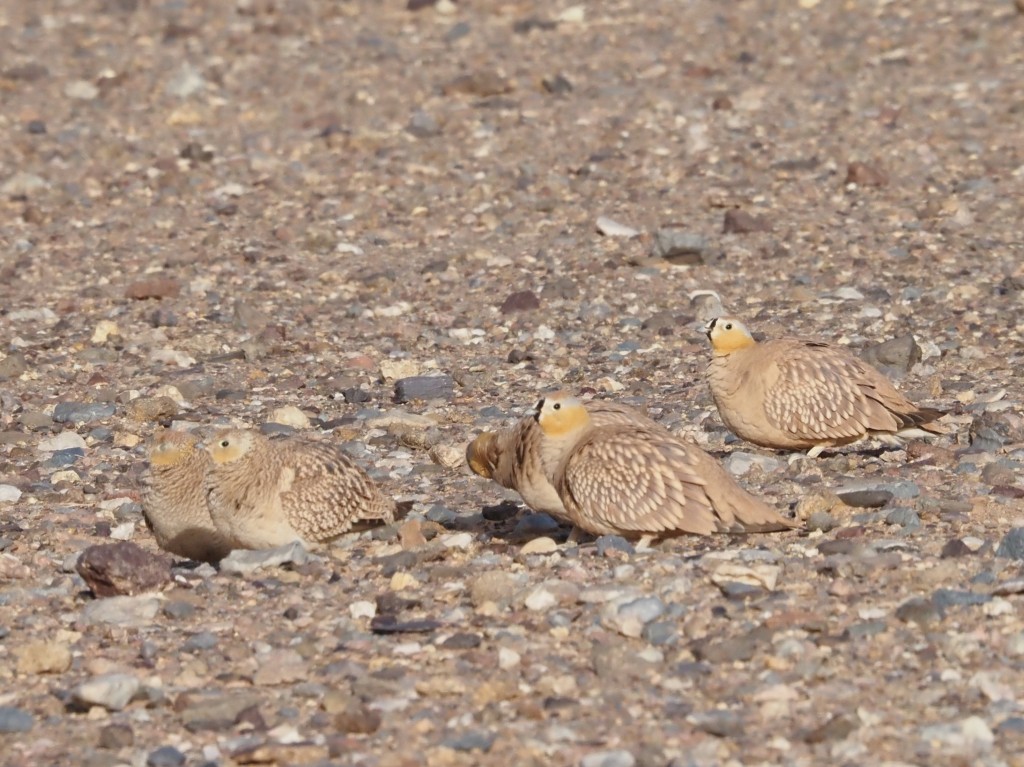




Day 10. Transfer day from the desert to Marrakech. But in the morning we still had time to explore the extensive palm groves near Merzouga. There we were lucky enough to find a gorgeous Fulvous Babbler! Other good birds in the area included Common Redstart and Maghreb Lark.


The roads in Morocco have improved a lot and only some hours after we were already in the Atlas alpine meadows, were we had another productive stop, adding Atlas Wheatear (a recent split from Northern Wheatear, a short-migratoy species that nests in the Atlas high plateaus and overwinters in the Sahel plains). Here, we also got 3 Booted Eagles migrating North and the only Water Pipit of the trip!
A pair of hours later we were arriving to Marrakech after crossing the Atlas, and a rather massive snowfall that was ending our 8th tour to Morocco, and the one with the most weird weather!!!
In 2023 we will come, same dates. Join for excellent birding and good fun!!
List of bird seen during the tour:
- 1. Barbary Partridge (Alectoris barbara)
- 2. Mallard (Anas platyrhynchos)
- 3. Gadwall (Anas strepera)
- 4. Eurasian Wigeon (Anas penelope)
- 5. Pintail (Anas acuta)
- 6. Eurasian Teal (Anas crecca)
- 7. Garganey (Spatula querquedula)
- 8. Marbled Teal (Marmaronetta angustirostris)
- 9. Northern Shoverler (Spatula clypeata)
- 10. Common Pochard (Aythya ferina)
- 11. Tutfed Duck (Aythya fuligula)
- 12. Common Swift (Apus apus)
- 13. Pallid Swift (Apus pallidus)
- 14. Little Swift (Apus affinis)
- 15. Pin-tailed Sandgrouse (Pterocles alchata)
- 16. Black-bellied Sandgrouse (Pterocles orientalis)
- 17. Crowned Sandgrouse (Pterocles coronata)
- 18. Spotted Sandgrouse (Pterocles senegallus)
- 19. Feral Dove (Columba livia)
- 20. Common Wood Pigeon (Columba palumbus)
- 21. Stock Dove (Columba oenas)
- 22. Eurasian Collared Dove (Streptopelia decaocto)
- 23. Laughing Dove (Streptopelia senegalensis)
- 24. European Turtle Dove (Streptopelia turtur)
- 25. Western Swamphen (Porphyrio porphyrio)
- 26. Common Moorhen (Gallinula chloropus)
- 27. Eurasian Coot (Fulica atra)
- 28. Little Crake (Zapornia parva)
- 29. Little Grebe (Tachybaptus ruficollis)
- 30. Great Crested Grebe (Podiceps cristatus)
- 31. Greater Flamingo (Phoenicopterus roseus)
- 32. Eurasian Stone Curlew (Burhinus oedicnemus)
- 33. Cream-coloured Courser (Cursorior cursor)
- 34. Eurasian Oystercatcher (Haematopus ostralegus)
- 35. Black-winged Stilt (Himantopus himantopus)
- 36. Pied Avocet (Revurvirostra avosetta)
- 37. Grey Plover (Pluvialis squatarola)
- 38. Common Ringed Plover (Charadrius hiaticula)
- 39. Little Ringed Plover (Charadrius dubius)
- 40. Kentish Plover (Charadrius alexandrinus)
- 41. Black-tailed Godwit (Limosa limosa)
- 42. Bar-tailed Godwit (Limosa lapponica)
- 43. Eurasian Whimbrel (Numenius phaeopus)
- 44. Eurasian Curlew (Numenius arquata)
- 45. Spotted Redshank (Tringa erythropus)
- 46. Common Redshank (Tringa totanus)
- 47. Greenshank (Tringa nebularia)
- 48. Green Sandpiper (Tringa ochropus)
- 49. Wood Sandpiper (Tringa glareola)
- 50. Common Sandpiper (Actitis hypoleucos)
- 51. Ruddy Turnstone (Arenaria interpres)
- 52. Sanderling (Calidris alba)
- 53. Little Stint (Calidris minuta)
- 54. Temminck’s Stint (Calidris temminckii)
- 55. Dunlin (Calidris alpina)
- 56. Curlew Sandpiper (Calidris ferruginea)
- 57. Red Knot (Calidris canutus)
- 58. Ruff (Calidris pugnax)
- 59. Black-headed Gull (Chroicocephalus ridibundus)
- 60. Lesser Black-backed Gull (Larus fuscus)
- 61. Yellow-legged Gull (Larus michahellis)
- 62. Mediterranean Gull (Larus melanocephalus)
- 63. Audouin’s Gull (Ichthyaetus audouinii)
- 64. Sandwich Tern (Thalasseus sandvicensis)
- 65. Gull-billed Tern (Gelochelidon nilotica)
- 66. Cory’s Shearwater (Calonectris diomedea)
- 67. White Stork (Ciconia ciconia)
- 68. Black Stork (Ciconia nigra)
- 69. Atlantic Gannet (Morus bassanus)
- 70. Great Cormorant (Phalacrocorax carbo)
- 71. Glossy Ibis (Plegadis falcinellus)
- 72. Eurasian Spoonbill (Platalea leucorodia)
- 73. Little Bittern (Ixobrychus minutus)
- 74. Western Cattle Egret (Bubulcus ibis)
- 75. Black-crowned Night Heron (Nycticorax nycticorax)
- 76. Purple Heron (Ardea purpurea)
- 77. Grey Heron (Ardea cinerea)
- 78. Little Egret (Egretta garzetta)
- 79. Great White Heron (Agrodiaetus albus)
- 80. Western Osprey (Pandion haliaetos)
- 81. Bonelli’s Eagle (Aquila fasciata)
- 82. Booted Eagle (Aquila pennata)
- 83. Short-toed Snake Eagle (Circaetus gallicus)
- 84. Western Marsh Harrier (Circus aeruginosus)
- 85. Pallid Harrier (Circus macrourus)
- 86. Long-legged Buzzard, aka Atlas Buzzard (Buteo rufinus cirtensis)
- 87. Eurasian Sparrowhawk (Accipiter nisus)
- 88. Little Owl (Athene noctua)
- 89. Pharaon Eagle Owl (Bubo ascalaphus)
- 90. Egyptian Nightjar (Caprimulgus aegiptius)
- 91. Red-necked Nightjar (Caprimulgus ruficollis)
- 92. Eurasian Hoopoe (Upupa epops)
- 93. Common Kingfisher (Alcedo atthis)
- 94. European Bee-eater (Merops apiaster)
- 95. Atlas Woodpecker (Picus vallantii)
- 96. Great Spotted Woodpecker (Dendrocopos major)
- 97. Eurasian Wryneck (Jynx torquilla)
- 98. Common Kestrel (Falco tinnunculus)
- 99. Lesser Kestrel (Falco naumanii)
- 100. Barbary Falcon (Falco peregrinoides)
- 101. Lanner Falcon (Falco biarmicus)
- 102. Black-crowned Tchagra (Tchagra senegalensis)
- 103. Algerian Shrike (Lanius excubitor algeriensis)
- 103b. Desert Grey Shrike (Lanius excubitor elegans)
- 104. Woodchat Shrike (Lanius senator)
- 105. Brown-necked Raven (Corvus ruficollis)
- 106. Common Raven (Corvus corax)
- 107. Red-billed Chough (Pyrrhocorax pyrrhocorax)
- 108. Magherb Magpie (Pica mauretanica)
- 109. Eurasian Jay (Garrulus glandarius)
- 110. Fulvous Babbler (Argya fulva)
- 111. Greater Hoopoe-Lark (Alaemon alaudipes)
- 112. Crested Lark (Galerida cristata)
- 113. Maghreb Lark (Galerida macrorrhyncha)
- 114. Thekla’s Lark (Galerida theklae)
- 115. Temminck’s Lark (Eremolauda temminckii)
- 116. Atlas Horned Lark (Eremophila alpestris atlas)
- 117. Mediterranean Short-toed Lark (Alaudala rufescens)
- 118. Greater Short-toed Lark (Calandrella brachydactyla)
- 119. Desert Lark (Ammomanes deserti)
- 120. Bar-tailed Lark (Ammomanes cinctura)
- 121. Barn Swallow (Hirundo rustica)
- 122. Western House Martin (Delichon urbicum)
- 123. Red-rumped Swallow (Cecropis daurica)
- 124. Sand Martin (Riparia riparia)
- 125. Plain Martin (Riparia paludicola)
- 126. Eurasian Crag Martin (Ptrynoprogne rupestris)
- 127. Zitting Cisticola (Cisticola juncidis)
- 128. Common Chiffchaff (Phylloscopus collybita)
- 129. Willow Warbler (Phylloscopus troquilus)
- 130. Western Bonelli’s Warbler (Phylloscopus bonelli)
- 131. Firecrest (Regulus ignacapilla)
- 131. Western Olivaceous Warbler (Iduna opaca)
- 133. Eurasian Reed Warbler (Acrocephalus scirpaceus)
- 134. Sedge Warbler (Acrocephalus schoenibaenus)
- 135. Saharan Scrub Warbler (Scotocerca saharae)
- 136. African Desert Warbler (Curruca deserti)
- 137. Western Orphean Warbler (Curruca hortensis)
- 138. Sardinian Warbler (Curruca melanocephala)
- 139. Western Subalpine Warbler (Curruca iberiae)
- 140. Tristam’s Warbler (Curruca deserticola)
- 141. Song Thrush (Turdus philomelos)
- 142. Mistle Thrush (Turdus viscivorus)
- 143. Eurasian Blackbird (Turdus merula)
- 144. Ring Ouzel (Turdus torquatus)
- 145. Blue Rock Thrush (Monticola solitarius)
- 146. Bluethroat (Luscinia svecica)
- 147. European Robin (Erithacus rubecula)
- 148. Black Redstart (Phoenicurus ochruros)
- 149. Common Redstart (Phoenicurus phoenicurus)
- 150. Moussier’s Redstart (Phoenicurus moussieri)
- 151. European Stonechat (Saxicola torquatus)
- 152. Northern Wheatear (Oenanthe oenanthe)
- 153. Atlas Wheatear (Oenanthe seebohmi)
- 154. Desert Wheatear (Onenanthe deserti)
- 155. Maghreb Wheatear (Oenanthe halophila)
- 156. Western Black-eared Wheatear (Oenanthe hispanica)
- 157. Red-rumped Wheatear (Oenanthe moesta)
- 158. Black Wheatear (Oenanthe leucura)
- 159. White-crowned Black Wheatear (Oenanthe leucopyga)
- 160. House Sparrow (Passer domesticus)
- 161. Spanish Sparrow (Passer hispanoliensis)
- 162. Common Rock Sparrow (Petronia petronia)
- 163. Dipper (Cinclus cinclus)
- 164. Spotless Starling (Sturnus unicolor)
- 165. Eurasian Wren (Troglodytes troglodytes)
- 166. Alpine Accentor (Prunella collaris)
- 167. Great Tit (Parus major)
- 168. African Blue Tit (Cyanistes teneriffae)
- 169. Atlas Coal Tit (Periparus ater atlas)
- 170. Short-toed Treecreeper (Certhia brachydactyla mauretanica)
- 171. Eurasian Nuthatch (Sitta europaeus)
- 172. Gray Wagtail (Motacilla cinerea)
- 173. White Wagtail (Motacilla alba)
- 174. Moroccan Wagtail (Motacilla subpersonata)
- 175. Yellow Wagtail (Motacilla flava)
- 176. Tawny Pipit (Anthus campestris)
- 177. Meadow Pipit (Anthus pratensis)
- 178. Tree Pipit (Anthus trivialis)
- 179. Water Pipit (Anthus spinolleta)
- 180. Eurasian Goldfinch (Carduelis carduelis)
- 181. Eurasian Siskin (Carduelis spinus)
- 182. Eurasian Greenfinch (Chloris chloris)
- 183. Linnet (Liniaria cannabina)
- 184. African Chaffinch (Fringilla coelebs africana)
- 184b. Common Chaffinch (Fringilla coelebs)
- 185. European Serin (Serinus serinus)
- 186. African Crimson-winged Finch (Rhodopechys alienus)
- 187. Corn Bunting (Emberiza calandra)
- 188. Rock Bunting (Emberiza cia)
- 189. House Bunting (Emberiza sahari)
- 190. Cirl Bunting (Emberiza cirlus)
List of mammals seen during the tour:
- 1. Barbary Ground Squirrel (Atlantoxerus getulus)
- 2. Fat Sand Rat (Psammomys obesus)

Thanks for arriving until down here! And, remember, in 2023 we will be back to enjoy the Moroccan birdlife!

